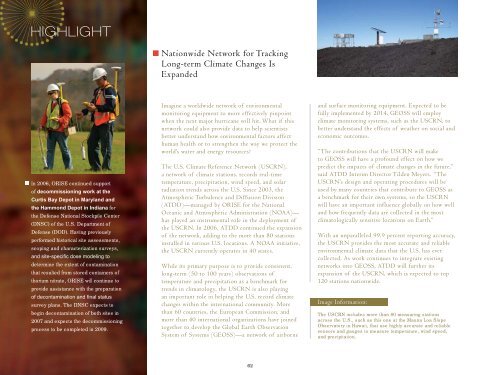Oak Ridge Associated Universities 2006 Annual Report
Oak Ridge Associated Universities 2006 Annual Report
Oak Ridge Associated Universities 2006 Annual Report
Create successful ePaper yourself
Turn your PDF publications into a flip-book with our unique Google optimized e-Paper software.
HIGHLIGHT<br />
Nationwide Network for Tracking<br />
Long-term Climate Changes Is<br />
Expanded<br />
In <strong>2006</strong>, ORISE continued support<br />
of decommissioning work at the<br />
Curtis Bay Depot in Maryland and<br />
the Hammond Depot in Indiana for<br />
the Defense National Stockpile Center<br />
(DNSC) of the U.S. Department of<br />
Defense (DOD). Having previously<br />
performed historical site assessments,<br />
scoping and characterization surveys,<br />
and site-specific dose modeling to<br />
determine the extent of contamination<br />
that resulted from stored containers of<br />
thorium nitrate, ORISE will continue to<br />
provide assistance with the preparation<br />
of decontamination and final status<br />
survey plans. The DNSC expects to<br />
begin decontamination of both sites in<br />
2007 and expects the decommissioning<br />
process to be completed in 2009.<br />
Imagine a worldwide network of environmental<br />
monitoring equipment to more effectively pinpoint<br />
when the next major hurricane will hit. What if this<br />
network could also provide data to help scientists<br />
better understand how environmental factors affect<br />
human health or to strengthen the way we protect the<br />
world’s water and energy resources?<br />
The U.S. Climate Reference Network (USCRN),<br />
a network of climate stations, records real-time<br />
temperature, precipitation, wind speed, and solar<br />
radiation trends across the U.S. Since 2003, the<br />
Atmospheric Turbulence and Diffusion Division<br />
(ATDD)—managed by ORISE for the National<br />
Oceanic and Atmospheric Administration (NOAA)—<br />
has played an instrumental role in the deployment of<br />
the USCRN. In <strong>2006</strong>, ATDD continued the expansion<br />
of the network, adding to the more than 80 stations<br />
installed in various U.S. locations. A NOAA initiative,<br />
the USCRN currently operates in 40 states.<br />
While its primary purpose is to provide consistent,<br />
long-term (50 to 100 years) observations of<br />
temperature and precipitation as a benchmark for<br />
trends in climatology, the USCRN is also playing<br />
an important role in helping the U.S. record climate<br />
changes within the international community. More<br />
than 60 countries, the European Commission, and<br />
more than 40 international organizations have joined<br />
together to develop the Global Earth Observation<br />
System of Systems (GEOSS)—a network of airborne<br />
and surface monitoring equipment. Expected to be<br />
fully implemented by 2014, GEOSS will employ<br />
climate monitoring systems, such as the USCRN, to<br />
better understand the effects of weather on social and<br />
economic outcomes.<br />
“The contributions that the USCRN will make<br />
to GEOSS will have a profound effect on how we<br />
predict the impacts of climate changes in the future,”<br />
said ATDD Interim Director Tilden Meyers. “The<br />
USCRN’s design and operating procedures will be<br />
used by many countries that contribute to GEOSS as<br />
a benchmark for their own systems, so the USCRN<br />
will have an important influence globally on how well<br />
and how frequently data are collected in the most<br />
climatologically sensitive locations on Earth.”<br />
With an unparalleled 99.9 percent reporting accuracy,<br />
the USCRN provides the most accurate and reliable<br />
environmental climate data that the U.S. has ever<br />
collected. As work continues to integrate existing<br />
networks into GEOSS, ATDD will further its<br />
expansion of the USCRN, which is expected to top<br />
120 stations nationwide.<br />
Image Information:<br />
The USCRN includes more than 80 measuring stations<br />
across the U.S., such as this one at the Mauna Loa Slope<br />
Observatory in Hawaii, that use highly accurate and reliable<br />
sensors and gauges to measure temperature, wind speed,<br />
and precipitation.<br />
62
















